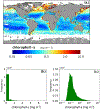An overview of approaches and challenges for retrieving marine inherent optical properties from ocean color remote sensing
- PMID: 30573929
- PMCID: PMC6296493
- DOI: 10.1016/j.pocean.2018.01.001
An overview of approaches and challenges for retrieving marine inherent optical properties from ocean color remote sensing
Abstract
Ocean color measured from satellites provides daily global, synoptic views of spectral waterleaving reflectances that can be used to generate estimates of marine inherent optical properties (IOPs). These reflectances, namely the ratio of spectral upwelled radiances to spectral downwelled irradiances, describe the light exiting a water mass that defines its color. IOPs are the spectral absorption and scattering characteristics of ocean water and its dissolved and particulate constituents. Because of their dependence on the concentration and composition of marine constituents, IOPs can be used to describe the contents of the upper ocean mixed layer. This information is critical to further our scientific understanding of biogeochemical oceanic processes, such as organic carbon production and export, phytoplankton dynamics, and responses to climatic disturbances. Given their importance, the international ocean color community has invested significant effort in improving the quality of satellite-derived IOP products, both regionally and globally. Recognizing the current influx of data products into the community and the need to improve current algorithms in anticipation of new satellite instruments (e.g., the global, hyperspectral spectroradiometer of the NASA Plankton, Aerosol, Cloud, ocean Ecosystem (PACE) mission), we present a synopsis of the current state of the art in the retrieval of these core optical properties. Contemporary approaches for obtaining IOPs from satellite ocean color are reviewed and, for clarity, separated based their inversion methodology or the type of IOPs sought. Summaries of known uncertainties associated with each approach are provided, as well as common performance metrics used to evaluate them. We discuss current knowledge gaps and make recommendations for future investment for upcoming missions whose instrument characteristics diverge sufficiently from heritage and existing sensors to warrant reassessing current approaches.
Keywords: Ocean color; bio-optics; inherent optical properties; satellite remote sensing.
Figures


References
-
- Abadi M, Agarwal A, Barham P, Brevdo E, Chen Z, Citro C, Corrado GS, Davis A, Dean J, Devin M, 2016. Tensorflow: Large-scale machine learning on heterogeneous distributed systems. arXiv, 1603.04467.
-
- Albert A, Mobley C, 2003. An analytical model for subsurface irradiance and remote sensing reflectance in deep and shallow case-2 waters. Optics Express, 11, 2873–2890. - PubMed
-
- Allali K, Bricaud A, Claustre H, 1997. Spatial variations in the chlorophyll‐specific absorption coefficients of phytoplankton and photosynthetically active pigments in the equatorial Pacific. Journal of Geophysical Research, 102 (C6), 12413–12423.
-
- Allison DB, Stramski D, Mitchell BG, 2010. Seasonal and interannual variability of particulate organic carbon within the Southern Ocean from satellite ocean color observations. Journal of Geophysical Research, 115, C06002, 10.1029/2009jc005347. - DOI
-
- Andre JM, 2002. Ocean color remote sensing and the subsurface vertical structure of phytoplankton pigments. Deep Sea Res. I, 39, 763–779.
